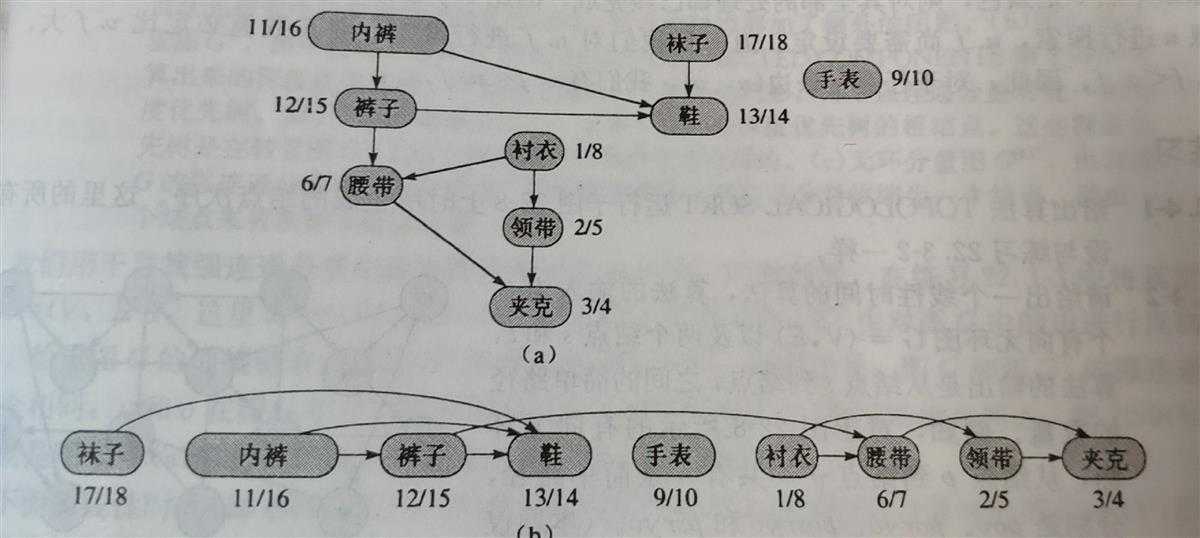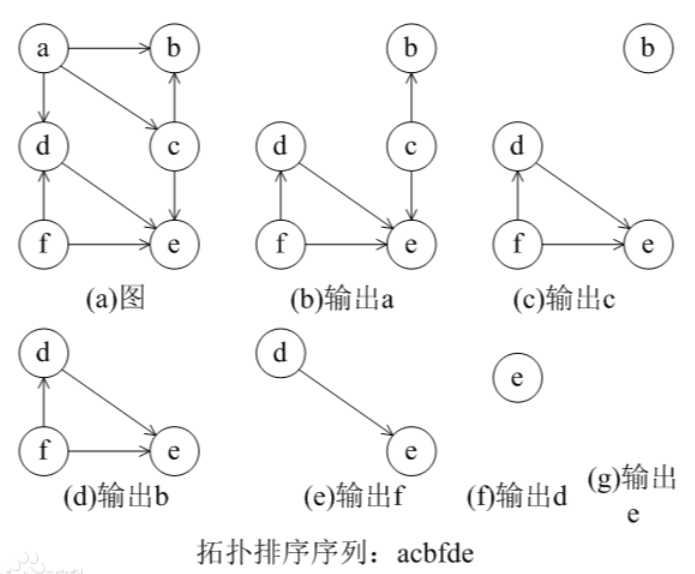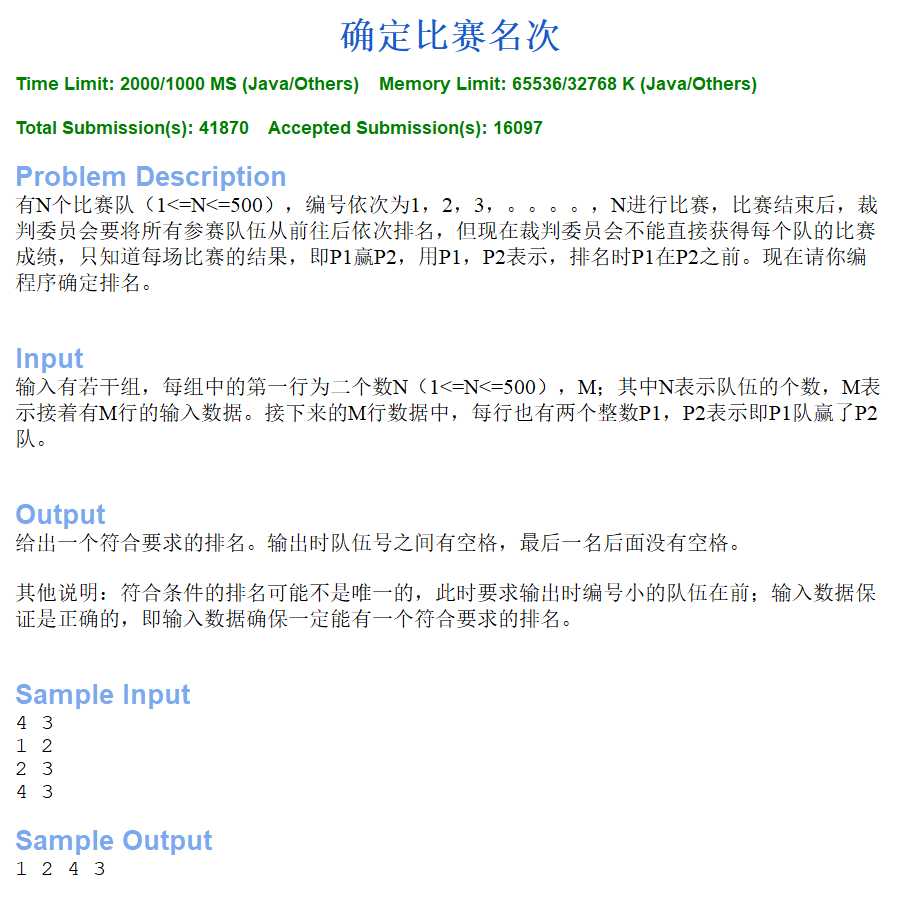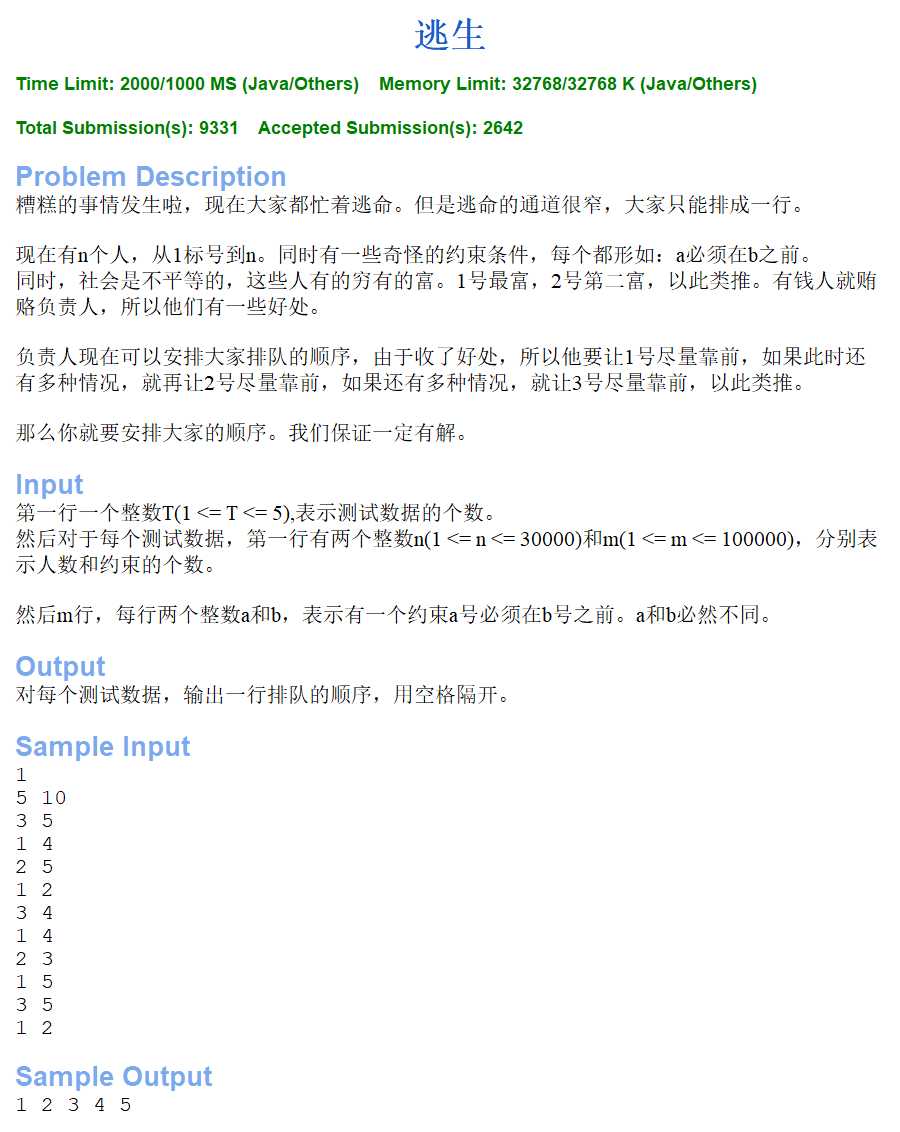标签:执行 网络 存在 click 正是 vector 图片 mamicode priority
在有向图中,用顶点表示活动,用有向边<Vi, Vj>表示活动Vi必须先于活动Vj进行。这种有向图叫作顶底表示活动的网络(Active on vertices),记作AOV网络。
在AOV网络中,如果活动Vi必须在Vj之前进行,则存在有向边<Vi, Vj>,并称Vi是Vj的直接前驱,Vj是Vi的直接后继。这种前驱与后继的关系具有传递性和反自反性,这要求AOV网络中不能出现回路,即有向环。因此,对于给定的AOV网络,必须先判断它是否存在有向环。
检测有向环可以通过对AOV网络构造它的拓扑有序序列(即进行拓扑排序,topological sorting)。该过程将各个顶点排列成一个线性有序的序列,使得AOV网络中所有的前驱和后继关系都能得到满足。
如果拓扑排序能够将AOV网络的所有顶点都排入一个拓扑有序的序列中,则说明该AOV网络中没有有向环,否则AOV网络中必然存在有向环。AOV网络的顶点的拓扑有序序列不唯一。可以将拓扑排序看做是将图中的所有节点在一条水平线上的展开,图的所有边都从左指向右。
用穿衣服的次序来描述拓扑排序,图(a)表示必须先穿某些衣服,才可以穿其他衣服,图(b)表示将拓扑排序后的有向无环图在一条水平线上展示出来。
袜子和内裤属于同等级,在排序结果中谁先谁后无所谓,平常生活中也是如此(丝袜除外![]() )。
)。

对于一个有向无环图
(1):统计所有节点的入度,对于入度为0的节点就可以分离出来,然后把这个节点指向的节点的入度-1。
(2):重复(1),直到所有的节点都被分离出来,拓扑排序结束。
(3):如果最后不存在入度为0的节点,那就说明有环,无解。

如果AOV网络有n个顶点,e条边,在拓扑排序的过程中,搜索入度为零的顶点所需的时间是O(n)。在正常情况下,每个顶点进一次栈,出一次栈,所需时间O(n)。每个顶点入度减1的运算共执行了e次。所以总的时间复杂为O(n+e)。
因为拓扑排序的结果不唯一,所以使用了优先级队列,即得到的是最小字典序的结果。

#include <iostream> #include <algorithm> #include <queue> #include <stdio.h> #include <vector> using namespace std; vector<int>head[505]; int in[505]; int main() { int n, m; cin >> n >> m; priority_queue<int, vector<int>, greater<int>>q; vector<int>ans; for (int i = 0; i < m; i++) { int c1, c2; scanf("%d%d", &c1, &c2); head[c1].push_back(c2); in[c2]++; } for (int i = 1; i <= n; i++) { if (!in[i]) { q.push(i); } } while (!q.empty()) { int temp = q.top(); q.pop(); ans.push_back(temp); for (int i = 0; i < head[temp].size(); i++) { in[head[temp][i]]--; if (!in[head[temp][i]]) q.push(head[temp][i]); } } if (ans.size() == n) { for (int i = 0; i < n; i++) { head[i + 1].clear(); cout << ans[i]; if (i != n - 1)cout << ‘ ‘; } cout << endl; } return 0; }
没有花头的模板题: http://acm.hdu.edu.cn/showproblem.php?pid=1285

代码:

#include <iostream> #include <algorithm> #include <queue> #include <stdio.h> #include <vector> using namespace std; vector<int>head[505]; int in[505]; int main() { int n, m; while (cin >> n >> m) { priority_queue<int, vector<int>, greater<int>>q; vector<int>ans; for (int i = 0; i < m; i++) { int c1, c2; scanf("%d%d", &c1, &c2); head[c1].push_back(c2); in[c2]++; } for (int i = 1; i <= n; i++) { if (!in[i]) { q.push(i); } } while (!q.empty()) { int temp = q.top(); q.pop(); ans.push_back(temp); for (int i = 0; i < head[temp].size(); i++) { in[head[temp][i]]--; if (!in[head[temp][i]]) q.push(head[temp][i]); } } if (ans.size() == n) { for (int i = 0; i < n; i++) { head[i + 1].clear(); cout << ans[i]; if (i != n - 1)cout << ‘ ‘; } cout << endl; } q.emplace(); ans.clear(); } return 0; }
反向拓扑排序: http://acm.hdu.edu.cn/showproblem.php?pid=4857

原文链接:https://blog.csdn.net/Lawliet1993/article/details/51043070
题意:n个结点,m个拓扑关系(a,b)表示a必须排在b前面,在满足m个拓扑关系关系的前提下使得小的结点尽可能的排在前面。也就是说我们现在要从1号结点开始考虑,如果要排1号结点,根据拓扑关系,首先必须排哪些结点,如果排好了1号结点,则继续考虑2号结点 ,3号结点。。
我们先看两个例子:
存在拓扑关系:
5 -> 3 -> 1
6 -> 4 -> 2
直接拓扑排序的结果是 5 3 1 6 4 2,结果是正确的(1号尽可能的在前面了) ,看起来好像直接拓扑排序就可以了,但是为什么提交后却wa了呢,别急,我们再看一个例子:
6 -> 3 -> 1
5 -> 4 -> 2
直接拓扑排序的结果是:5 4 2 6 3 1 ,结果是错误的,因为我们可以把1号安排到更前面的位置 即:6 3 1 5 4 2(正确答案)。
看到这里应该就知道为什么直接拓扑排序不行了吧,我们分析一下为什么会出现这样的状况,对于多条弧或者边,我们是先删除弧尾结点比较小的结点即(5号结点比6号结点小,先删除以该点为尾的弧),而这也正是问题所在,我们希望的是优先删除弧头比较小的弧的(1号结点比2号结点小,因优先删除以1号为头的弧)。
好了,问题找到了,现在我们在来想如何解决问题,我们可以尝试一下逆向思维,即我们先考虑哪些点应该靠后释放,这样的话我们就可以把拓扑关系反过来(即弧头和弧尾调换),然后做拓扑排序,然后我们可以根据原来的弧头(现在变成弧尾)的大小来释放结点,由于现在的问题变成哪些最后释放,那么就应该优先考虑弧尾(原来的弧头)比较大的,可以通过优先队列来解决。

#include <iostream> #include <algorithm> #include <queue> #include <stdio.h> #include <vector> using namespace std; vector<int>head[30005]; int in[30005]; int main() { int T; cin >> T; while (T--) { int n, m; cin >> n >> m; priority_queue<int>q; vector<int>ans; for (int i = 0; i < m; i++) { int c1, c2; scanf("%d%d", &c1, &c2); /*head[c1].push_back(c2); in[c2]++;*/ head[c2].push_back(c1); in[c1]++; } for (int i = 1; i <= n; i++) { if (!in[i]) { q.push(i); } } while (!q.empty()) { int temp = q.top(); q.pop(); ans.push_back(temp); for (int i = 0; i < head[temp].size(); i++) { in[head[temp][i]]--; if (!in[head[temp][i]]) q.push(head[temp][i]); } } if (ans.size() == n) { for (int i = n - 1; i >= 0 ; i--) { head[i + 1].clear(); cout << ans[i]; if (i != 0)cout << ‘ ‘; } cout << endl; } q.emplace(); ans.clear(); } return 0; }
标签:执行 网络 存在 click 正是 vector 图片 mamicode priority
原文地址:https://www.cnblogs.com/czc1999/p/10863619.html